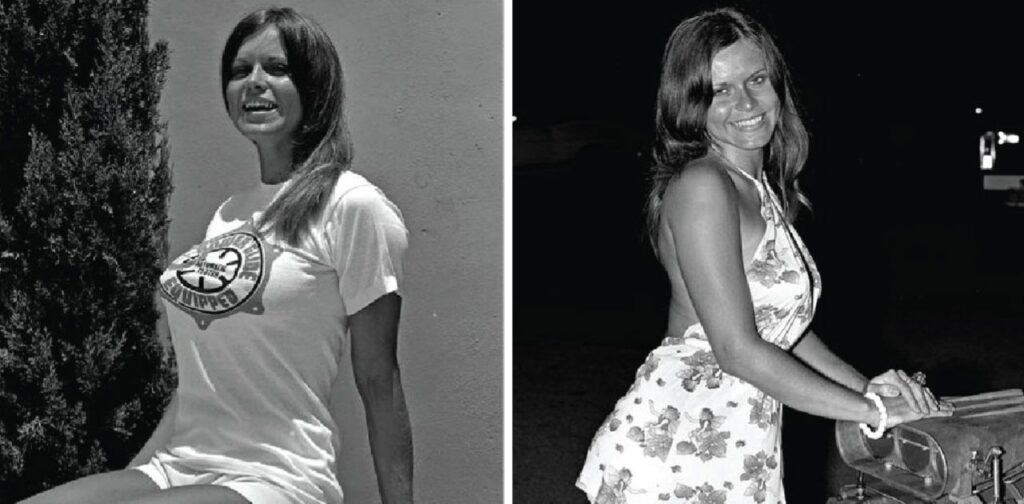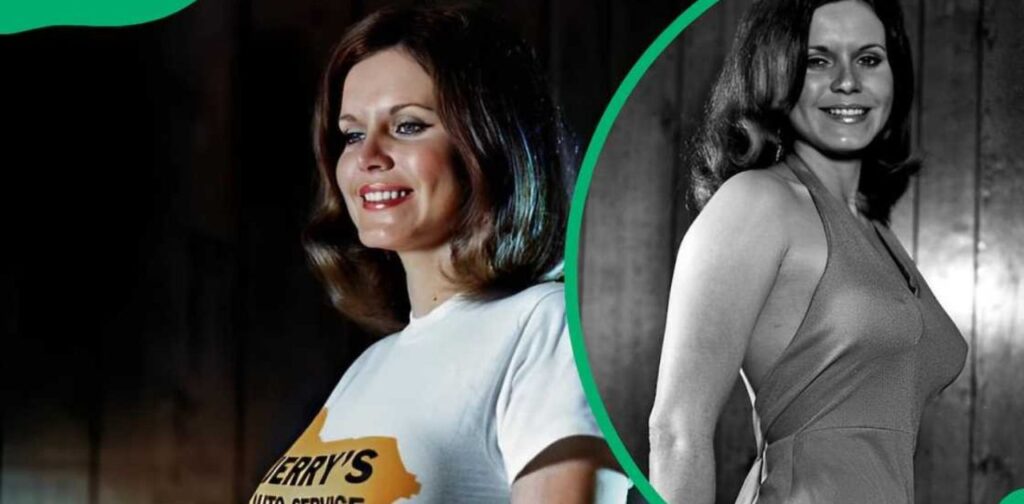Barbara Roufs was a prominent figure in the drag racing scene of the 1970s, known for her role as a trophy girl and model. With her stunning looks and captivating presence, Barbara broke the mold of traditional trophy girls, who were typically much younger.
Her career in the racing industry brought her significant fame and admiration, but her life was tragically cut short in January 1991 when she died by suicide at the age of 47. Despite the mystery surrounding her death, Barbara Roufs is remembered for her contributions to drag racing and her unique influence on the sport’s culture.
Barbara Roufs Quick Bio
Barbara Roufs was a renowned figure in the drag racing scene of the 1970s. Born in 1944 in California, United States, Barbara became one of the most famous drag race trophy girls of her time. Known for her stunning looks and charismatic presence, she brought a unique flair to the racing world, which was predominantly male-dominated. Standing at 5 feet 5 inches tall with brown hair and eyes, Barbara was not just a pretty face but a trailblazer who left a lasting impact on the sport.
She was married and had one daughter, Jet Dougherty, but details about her husband and family life were largely kept private. Tragically, Barbara’s life ended in January 1991 when she committed suicide at the age of 47. Despite the mystery surrounding her death, her contributions to drag racing remain a significant part of her legacy.
Read Also: McKinzie Valdez: A Journey from Texas to TikTok Stardom
Who was Barbara Roufs?
Barbara Roufs was an American drag race trophy girl and model who gained significant fame and popularity in the 1970s. Known for her striking appearance and the ability to captivate audiences, Barbara was a standout figure in an era when the role of trophy girls in racing was evolving. Unlike the younger women typically chosen for the role, Barbara was older, which made her presence even more impactful in a field that often prioritized youth. Her charisma and confidence on the racing circuit earned her a unique place in the hearts of fans and participants alike.
Barbara’s involvement in drag racing came at a time when the sport was gaining substantial traction in American culture. Trophy girls like Barbara were not just there to present awards; they were an essential part of the spectacle, adding glamour and excitement to the events. Barbara, with her broad smile and signature go-go boots, epitomized the spirit of the 1970s, a time of change and breaking away from traditional norms. She was a favorite for many racing companies, who utilized her image to market their products, including clothing lines that targeted the racing audience.
Despite her public persona, Barbara was known to keep her private life away from the limelight. This added an air of mystery around her, making her even more intriguing to fans and the media. Barbara’s life, however, was not just about glitz and glamour; it also had its share of challenges, which culminated in her untimely death in 1991.
The Early Life of Barbara Roufs
Barbara Roufs was born in 1944 in California, a state known for its vibrant culture and diverse opportunities. Growing up in California, Barbara was surrounded by the booming automotive culture, which might have influenced her later involvement in drag racing. She was raised in a loving and supportive family environment, which helped shape her into the confident and charismatic individual she would become.
Her early life was marked by the presence of her parents, Thelma Ruby Riley and Wayne Eldon Riley, who played significant roles in her upbringing. Barbara had three biological siblings: Vivian Deaton, James, and Bruce. She also had an adopted brother, Ben Gube. Growing up in a large family, Barbara learned the values of hard work, determination, and resilience, traits that would serve her well in her future career as a trophy girl and model.
Barbara’s childhood was relatively normal, filled with the joys and challenges of growing up in mid-20th century America. She attended local schools in California and was known to be a bright and outgoing student. It was during these formative years that Barbara developed an interest in fashion and performance, often participating in school events and local beauty pageants. Her natural beauty and talent for engaging an audience did not go unnoticed, and it wasn’t long before she began to consider a career that would allow her to showcase these attributes on a larger stage.
Thelma Ruby Riley – Barbara’s Mother
Thelma Ruby Riley, Barbara’s mother, was a woman of many talents and a significant influence on Barbara’s life. Born and raised in California, Thelma was known in her community for owning and operating a beauty salon in Clovis, California, for nearly 50 years. Her salon was more than just a place for haircuts; it was a community hub where local women gathered to socialize, share news, and support each other. Thelma’s entrepreneurial spirit and dedication to her craft made her a respected figure in the community, and she instilled these values in her children.
In addition to running her salon, Thelma was also deeply involved in her church, the Nazarene Calvary Bible Church, where she served as the organist. Her commitment to her faith and her community provided a strong moral foundation for her family. Thelma’s ability to balance her professional life with her responsibilities as a mother and community leader was a source of inspiration for Barbara, who admired her mother’s strength and perseverance.
Thelma passed away in 2005, just a few years after Barbara’s tragic death. Her passing marked the end of an era for her family and the community she served for so long. Despite the challenges, Thelma’s legacy of hard work, community service, and resilience continued to live on through her children and the many lives she touched.
Wayne Eldon Riley – Barbara’s Father
Wayne Eldon Riley, Barbara’s father, was a man of diverse interests and passions. Known for his love of motorcycles and racing, Wayne was an enthusiastic participant in the local racing scene at the Kearney Bowl, a popular racing venue in California. His passion for speed and adventure likely influenced Barbara’s own interest in the racing world. Wayne was also an avid fisherman and spent much of his free time on his houseboat at McClure Lake, where he found peace and relaxation away from the hustle and bustle of everyday life.
Wayne and Thelma were known for their strong and loving relationship, which served as a model of partnership and mutual respect for their children. They were the first couple to be inducted into the Clovis Hall of Fame, recognized for their contributions to the community and their exemplary marriage. Wayne’s adventurous spirit and love for life left a lasting impression on Barbara, who inherited his passion for racing and his zest for life.
Professional Career of Barbara Roufs
Barbara Roufs began her professional career in the late 1960s as a trophy girl in the drag racing circuit. This role involved more than just presenting trophies; it was about being the face of the event, engaging with fans, and adding an element of glamour and excitement to the races. Barbara quickly gained popularity for her stunning looks, broad smile, and the confident way she carried herself on the racetrack. Her fashion sense, often characterized by go-go boots and other trendy 1970s attire, set her apart from the other trophy girls.
In 1973, Barbara was crowned the PDA Professional Dragster Association Queen, a title that cemented her status as one of the most popular figures in drag racing. Her role as a trophy girl made her a sought-after personality in the racing community, with many brands and companies eager to have her represent their products. Barbara’s popularity extended beyond the racing tracks; she became a cultural icon of the 1970s, representing the changing attitudes towards women in sports and entertainment.
Despite being older than many of her counterparts, Barbara’s mature beauty and professional demeanor made her a favorite among fans and brands alike. Her career in drag racing helped redefine what it meant to be a trophy girl, shifting the focus from mere beauty to a combination of charisma, professionalism, and the ability to connect with an audience. Barbara’s influence helped pave the way for future generations of women in racing, showing that age and experience could be assets in a field that often prioritized youth.
Is Barbara Roufs Married?

Barbara Roufs was indeed married, although she kept the details of her marriage largely private. She had one daughter, Jet Dougherty, who was born when Barbara was 29 years old. Despite her public persona as a trophy girl and model, Barbara rarely spoke about her personal life, including her marriage and the identity of her husband. This secrecy added an element of mystery to her life, with fans and the media often speculating about her relationships and family life.
Barbara’s decision to keep her marriage and personal life private may have been influenced by the culture of the time, which often placed a heavy emphasis on a woman’s public image, especially in the entertainment and sports industries. By keeping her private life out of the spotlight, Barbara was able to maintain a sense of normalcy and protect her family from the prying eyes of the public. Her daughter, Jet, has also maintained a low profile, respecting her mother’s wishes to keep their family life private.
Cause of Death/The Mystery of Death
Barbara Roufs’s death in January 1991 was a shock to her fans and the racing community. At the age of 47, Barbara took her own life, a fact that her daughter, Jet Dougherty, confirmed many years later. The reasons behind her suicide remain unclear, and Jet did not provide specific details about what might have led her mother to such a tragic end. Barbara’s death left a void in the drag racing community, where she had been a beloved figure for many years.
The mystery surrounding Barbara’s death has led to much speculation and numerous theories. Some believe that the pressures of maintaining her public image and career might have contributed to her decision to end her life. Others speculate that there may have been personal issues or mental health struggles that were never publicly disclosed. Whatever the reason, Barbara’s death was a tragic end to a life that had brought so much joy and excitement to others.
In 2016, a photographer named Tom West uploaded photographs of Barbara from her days as a trophy girl, bringing her back into the public eye. This post prompted Jet to speak out about her mother, paying tribute to her contributions to drag racing and expressing her gratitude for the continued love and support from Barbara’s fans. Jet’s comments highlighted the lasting impact that Barbara had on the racing community and the deep sense of loss that her death had caused.
Barbara Roufs Net Worth
At the time of her death in 1991, Barbara Roufs’s net worth was estimated to be around $1 million. This figure was largely accrued from her work as a trophy girl and model in the drag racing circuit, as well as through endorsements and partnerships with various racing brands. Barbara’s unique appeal and ability to connect with audiences made her a valuable asset to the racing community, and her work helped elevate the role of trophy girls in motorsports.
Barbara’s net worth was a testament to her success in a field that was, at the time, largely male-dominated. Her ability to carve out a space for herself in the racing world, despite the challenges and stereotypes she faced, speaks to her determination and business acumen. She was able to leverage her popularity to secure lucrative deals and opportunities, ensuring that she was financially stable even after her career in racing began to wind down.
Conclusion
Barbara Roufs left an indelible mark on the drag racing world as a trophy girl and model who broke stereotypes with her unique appeal, professionalism, and resilience. Her life was a blend of glamour and challenges, marked by her dedication to her career and the mystery surrounding her tragic death.
Despite her untimely passing, Barbara’s influence continues to be felt, reminding us of the complexities behind public personas and the lasting impact one individual can have on an entire industry. Her story remains a powerful testament to the spirit and determination needed to navigate the world of motorsports, and she is remembered as a pioneering figure who transformed the role of women in drag racing.
Latest Article

Youthful insight with exceptional writing skills, delivering engaging and thought-provoking content.



